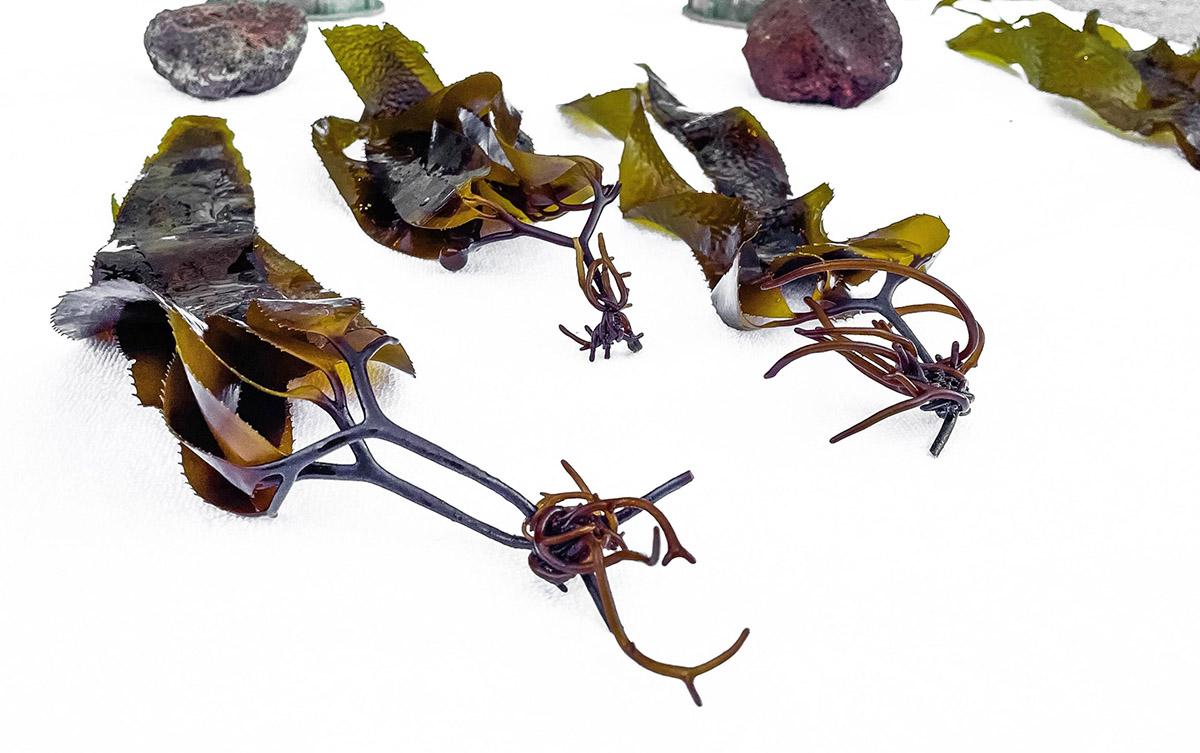
4:23
The concept: Sinking invasive seaweed into the ocean depths to better manage carbon released into the atmosphere.
The stakes: $100 million in prize money awarded to qualifying teams competing in the XPRIZE Carbon Removal challenge – and creating climate change solutions.
The team: California-based Pull To Refresh is iterating on autonomous solar-powered vessels that can use invasive seaweed to remove extra CO2 from the carbon cycle. The highly-collaborative team is using Onshape to achieve this.
A closeup of seaweed. (Courtesy: Pull To Refresh)

The XPRIZE Carbon Removal Competition
Before co-founding Pull To Refresh, Arin Crumley and Laurel Tincher met on the social audio app Clubhouse in a group dedicated to discovering attainable solutions to climate change.
Already touting successful careers in filmmaking (Arin) and marketing (Laurel), the two heard the call for innovators who want to help build a sustainable future, along with Christian Robinson, the company’s third co-founder.
“The reason that I specifically segued into this realm was because of seeing what was happening in the world – I was already kind of sensitive to caring about the environment and worried about the climate,” Arin says. “But then it hit real close to home when, where I grew up and went to high school, that neighborhood got totally just evaporated into fire.”
“I just decided I should be doing something that is actually helping this situation,” he adds.
Enter the XPRIZE Foundation, a nonprofit that designs global competitions to speed up advancements in various markets. Its competitions last years and dole out cash prizes to teams throughout the life of the challenge.
Pull To Refresh is part of the Carbon Removal challenge, which touts the largest incentive prize in XPRIZE history with $100 million funded by the Musk Foundation. The competition began in 2021 and ends in April 2025.
Sinking Seaweed to Remove Carbon
After plenty of research and meetings about which sustainable idea to pursue, the team saw sinking seaweed as the opportunity to make a real impact.
“We came to like the invasive seaweed idea,” Arin explains. “You don't have to cultivate it. You just have to go out and find it.”
The idea is to capture CO2 from invasive seaweed, then remove it from the carbon cycle by sequestering it to the bottom of the ocean floor. Typically, CO2 is rereleased as the plant dies off closer to the ocean surface. But by sinking kelp for carbon sequestration, the CO2 can be trapped and kept out of the atmosphere for hundreds to thousands of years.
Seaweed is more efficient at capturing CO2 than trees because of its rate of growth. But can it remove enough? In order to return to safe levels and prevent catastrophic climate change, a report from the Intergovernmental Panel on Climate Change (IPCC) stated that around 1 trillion tons of CO2 must be removed by the year 2100.
“Maybe we can get it done by the 2060s, which is what we believe is possible,” Arin says.
Sargassum seaweed, which is invasive.
(Courtesy: Pull To Refresh)

As for the team name, Laurel explains that on the Clubhouse app, users have to pull to refresh the page for updates.
“We realized that it related to our project,” she says. “Basically, we're pulling CO2 out of the atmosphere to refresh the Earth. So it had that double meaning for us.”
Designing a Sinking Seaweed System
With a solution and a goal in mind, the team began to figure out the best way to build, power, manufacture, and scale seaweed vessels.
“We identified where on the map there is both the invasive seaweed and sufficient depths,” Arin says. “The only problem is it's dangerous out there. It's expensive. You have all this fuel cost. That's what led us down this path to get some design tools together. Let's get some design talent together. We're gonna have to start recruiting 3D modelers.”
Laurel testing out the first vessel. (Courtesy: Pull To Refresh)

The first design was made on paper with a crayon. Eventually, with plenty iterations, the team was able to transform their idea into a a 3D model that could then be shared with suppliers and manufacturers who could provide feedback using tools unique to Onshape.
By focusing on a streamlined relationship with manufacturers, the Pull To Refresh team is able to ensure that the design is scalable and easy to put together without wasting resources or time.
With such a big idea, the team relied on a global talent pool to help iterate on the vessel’s design, which is one reason why they used Onshape to bring their vision to life.
“Bringing together different talent and seeking them out and finding them – that's a huge part of what this project is and it's so collaborative,” Arin says. “So we demand the best collaboration tools.”
Onshape’s tools that ease collaboration include one-link sharing and browser-based access from anywhere.
The other reason Pull To Refresh chose Onshape?
“There is a commitment to supporting innovation that's important,” Arin says. “That's actually what turned us on to Onshape.”
The Onshape Startup Program
Equip your team with full-featured CAD, built-in PDM, and analytics in one system.
Latest Content

- Case Study
- Industrial Equipment & Machine Design
Reframe Systems: Transforming Homebuilding with Digital Automation and Cloud-Native Onshape
09.25.2025 learn more
- Blog
- Becoming an Expert
- Assemblies
- Simulation
Mastering Kinematics: A Deeper Dive into Onshape Assemblies, Mates, and Simulation
12.11.2025 learn more
- Blog
- Evaluating Onshape
- Learning Center
AI in CAD: How Onshape Makes Intelligence Part of Your Daily Workflow
12.10.2025 learn more
- Blog
- Evaluating Onshape
- Assemblies
- Drawings
- Features
- Parts
- Sketches
- Branching & Merging
- Release Management
- Documents
- Collaboration
Onshape Explained: 17 Features That Define Cloud-Native CAD
12.05.2025 learn more



